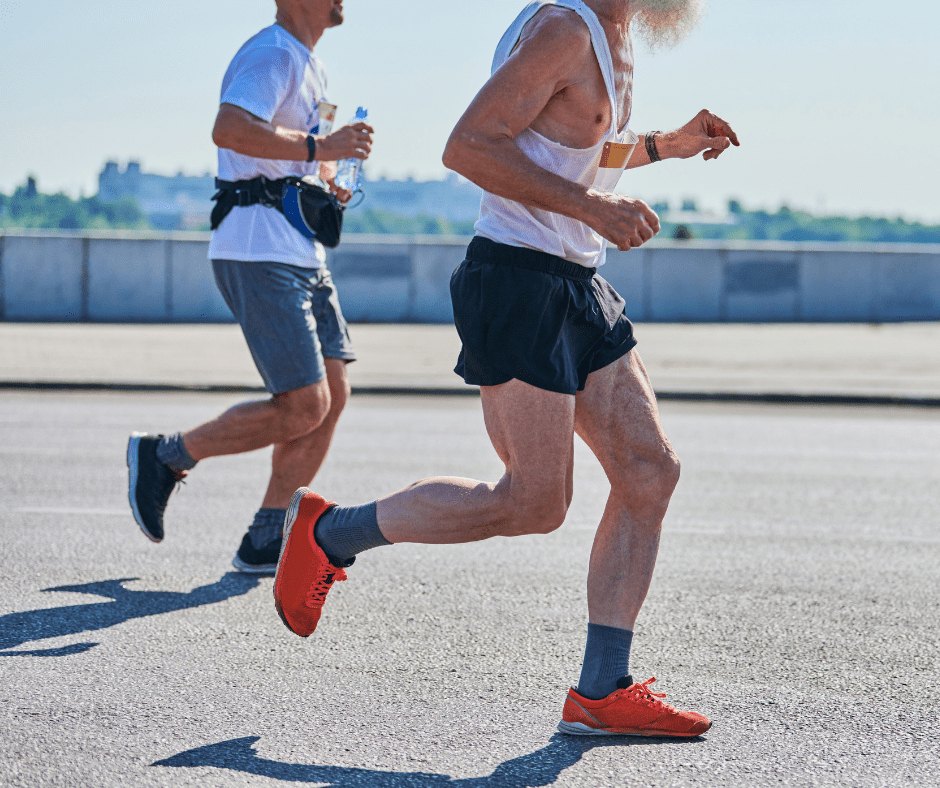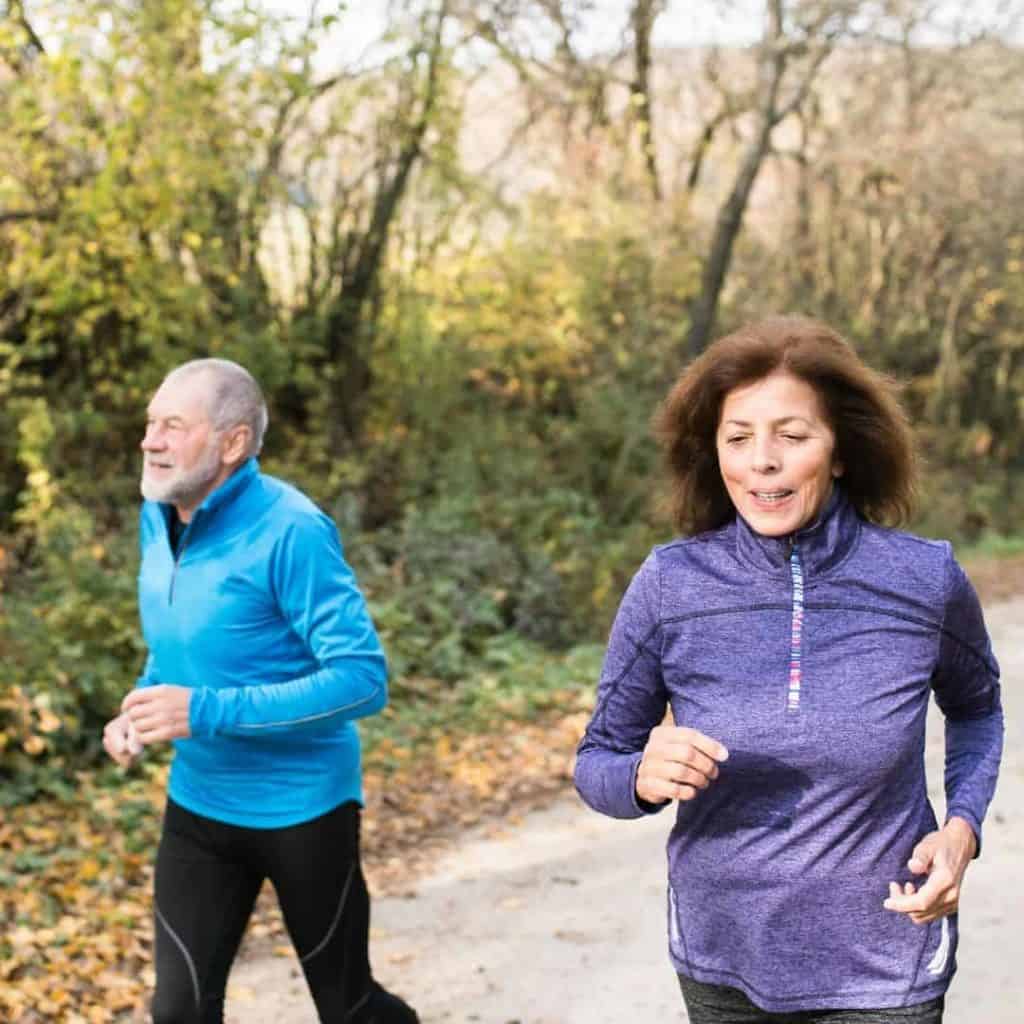There is no doubt about it, your body changes with each new decade you enter, and this affects your running…
It is well documented that our physiology starts letting us down way before we’d like it to. Many studies show peak performance ages to be between 20-35 years of age for most sports and the physiological decline imminent thereafter.
Many people think getting older means that you need to cut back on physical activity to avoid injuries… This is not truly leading an active lifestyle after the age of 50 keeps your muscles and bones strong, your mind sharp, and can add years to your life.
Let’s discover why running over the age of 50 is good for you as well as the elements that come with running in your 50s, 60s, 70s and beyond.

Running Is Good For You As You Get Older
Studies suggest that running over 50 years old, whether you are experienced or not, is a great way to improve cardiovascular fitness.
What’s even more impressive is that middle-aged, beginner runners will gain the same benefits as experienced, middle-aged runners.
Some of the benefits of running in your 50s and beyond include healthier muscle mass, a stronger heart, and less body fat.
Check out this fantastic article we wrote a while back about: The Race Against Age: How To Slow Down The Slowing Down
Health Benefits Of Running In Your 50’s & Beyond
- Cardiovascular Health
According to the Journal of American College Of Cardiology: Running can decrease your risk of death from cardiovascular disease by 45%.
This is due to HDL (high-density lipoprotein) cholesterol “good cholesterol” and improved blood pressure.
- Improved Quality Of Sleep
In our modern lifestyles, sleep is quite hard to come by. The number of hours of sleep but more importantly the quality of sleep that we have is particularly poor.
Sleep is one of the non-negotiable pillars of recovery, training, and ensuring you get to the next workout feeling good. Have a more detailed look at the critical role sleep plays in our running recovery.
Running boosts the serotonin hormone, which is involved in your sleep-wake cycle. This may improve the brain’s ability to metabolize serotonin and regulate sleep.
The benefits of getting a good quality night’s sleep include:
- Improved ability to build muscle & repair tissue
- Improved athletic performance
- Balanced hormones
- Water reabsorption
- Improved concentration
- Better Bone Density
Running brings a lot of advantages but one of the amazing benefits that you get for free, when you train regularly is good bone health.
Good bone health implies a little bit of strength, but also bone mineral density. Our bones support us and allow us to move.
Our bones also store minerals such as calcium and phosphorous, which help keep our bones strong, and release them into the body when we need them for other uses.

This is not as effective as running on its own vs running and strength training.
- Lowered Risk Of Chronic Lifestyle- Related Diseases
According to the National Center for Chronic Disease Prevention and Health Promotion, running helps reduce your risk of chronic conditions such as type 2 diabetes, heart disease, many types of cancer, depression, anxiety, and dementia.
Have a look at this article we wrote covering Science-based nutrition training and relevant nutritional advice for over 50-year-old runners.
Now that we know that running when you’re over 50 is good and comes with a lot of benefits, let’s have a look at what running when you are over the age of 50 entails…
Why Is Running Harder As You Get Older?
- Your body needs more recovery time in your 50s & 60s and beyond.
What we have found, particularly with athletes that move into their 50’s and more so into their 60’s is that we can get a lot better results on a lot less training than before because the recovery times are slower and so that extra recovery time that we add in actually allows runners to get better.
If we use Coach Lindsey Parry’s father as a really good example, once he finally started listening to Lindsey. His original investment in my degree didn’t seem to be enough to trigger him to take any advice. But eventually, he was sort of forced into taking advice.
We moved him from running his traditional seven days a week, which he’d been running for four decades; to running four days a week, and over the next seven years, his dad got faster and faster. Over seven years until he ran at the age of 62, he started running times in races that he was running in his early 50s.
Finding the right balance is important in your 50s.
Since then he’s kind of steadily gotten slower and slower, but really what I’m trying to say, is it’s about finding the right balance for you.
So that you can either just slow down or reduce the rate of slowing down or in the short term get some more improvement.
The only way you can do it is by getting the right mix between training and recovery and that probably doesn’t mean training more.
It means training a little bit less and adding some strength training into the mix.
Whether you know a thing or two about strength- training or have never thought of doing it before… many benefits come with it but there’s one that always seems to get noticed the most and it’s that strength training will improve your running. -> 10 Strength Training Tips That Will Get You Running Like A Pro
- A decrease in muscle mass, strength & power
Over time our muscle mass decreases and along with this, there is a more rapid loss of Type II (“fast fibers”).
So, what this means is that there is a slight change in the muscle mass we have from a more slow-twitch fiber, which essentially means less speed.
There is also a change in the neuromuscular connection between the brain and muscle fibers which means “messages sent from the brain to muscles” are less frequent and less efficient, also having an effect on muscle contractions as well as proprioception (which affects the increase in the risk of falling)
More than just the change in muscle fiber is the loss of lean muscle mass.
This is generally linear through your 30s and 40s from your 50s the loss becomes more exponential and therefore this is possibly one of the main reasons for slowing down, and struggling with usual activities of daily living. We are asking our bodies to do the same amount of work with less capacity due to this loss of lean muscle mass…
- As we get older, we see a decline in maximum heart rate.
Most age-related HRmax formulas are sufficient for a general idea for the general population however there is a lot of variance with these formulas and they are not very dependable at an individual level, and they get less reliable with more aging populations.
It is important for you to figure out your HRmax with the use of a laboratory test or a maximum exhaustive field-based test. This is why we prefer to use threshold HR rather than max HR.
Watch the video below where we explain exactly how to use threshold heart rate in your training:
- A Reduction in VO2peak (Cardiovascular)
As a result of the decline in max heart rate, we start to see a decline in peak VO2 in athletes as they get older.
It could, therefore, be assumed that with the decline in VO2peak as you age, your running performance could also decline.
The TRUTH About VO2 Max: Does VO2 Max ACTUALLY Matter?
- A decrease in tendon elasticity & increased stiffness (Musculoskeletal)
This decrease in tendon elasticity could place the older endurance runner at a higher risk for musculoskeletal injuries.
And so, the loading and prescription, as well as strength training of a runner over the age of 50, is key to ensuring the longevity and health of the runner.

Join us for a free online presentation of the…
The Faster Beyond 50 Masterclass
…and discover how you can run well (and faster) as you get older, without training more or harder than you currently are, all while avoiding injury.
If it feels like you’re training harder than ever but not running the paces you’d like to be running or if you’re constantly tired, fatigued or running in some sort of pain, then this is specifically for you.
Save your seat in this training now…
Start Running After 50: How To Take Up Running Later In Life
We’re going to share with you five tips and really important things that you need to take care of to make sure that you can run well beyond your 50s…
It’s never too late to start running and in fact, we always tell people if you start later… it just means you can improve well into your twilight years.
If you’re thinking about starting running… then now is the time.
We’re going to order them from least important to most important to ensure you read to the END of the article!;)
Five Tips For Starting To Run In Your 50’s
5: Cross-Training
Cross-training is your friend when you start running in your 50s because you do need to start slowly and so the cross-training will help you to reduce some of that frustration and allow you to maybe push yourself a little bit harder than you may want to or to feel like you are getting in some exercise.
Cross-training includes nonimpact cardiovascular exercises such as swimming, stationary cycling, or cycling, and some rowing even the elliptical.
These exercises don’t contribute to the load that you’re placing on particularly your joints, tendons, and ligaments while running, but contribute to building your aerobic capacity.
Revealed: How To Swim Your Way To Becoming A Better Runner
4: Don’t run more than four days a week
When you’re starting out running in your 50s you want to run between three to four days per week, maximum; and that will allow you to give your body the time that it needs to recover from each time that you got out there and put that stress on your tendons, muscles, ligaments, and joints.
I know I am making it sound like running is bad for you…. It’s not, it’s an amazing exercise for you, particularly as you get older.
But we do want to make sure that you can enjoy those fruits without breaking down with an injury.

Remember that recovery is extremely important because you only get the benefit of your training when you recover.
3: Build up slowly.
You do want to build up slowly, in fact, the slower that you can stand to build up, the less likely you are to get sick and injured.
This will result in you being more likely to start loving running in a couple of weeks, and more likely you are to stick it out and turn it into something that you do well into your advanced years.
That again is where the cross-training comes in.
While you’re building this running slowly, you can then throw in a little bit of harder cycling, rowing, and elliptical things that are much less likely to cause injury.

2: Strength Training
If you are just starting, doing exercise full stop, your muscles will have atrophied over years and that atrophy will have accelerated in your middle, the mid to late 40s.
It will accelerate even faster now that you are in your 50s.
Strength training becomes incredibly important to allow your body to cope with this new exercise regime that you’re going to do.
Once you start getting really into it two, or three months down the line, it’s going to help you to become a much better runner, protect your body from injury, and will help delay the loss of performance from the loss of lean muscle mass because you will be combatting the natural effects of aging with strength training
Here at Coach Parry we a massive advocates of strength training, especially as we get older. That is why we’ve created this free masters strength training plan for you to download.
1: You need to walk before you run.
That does not mean that you have to go out and you’re not allowed to run at all.
Remember: Walking is not a weakness!
It means that when you start, walking reduces the load and stress running causes, but still allows you to gain that aerobic benefit and allows you to go further for longer at less cost to your body.
The running stress is greater than the walking but that gradual change from walking to running is what’s going to allow you to get into this sport and reap the benefits that you should be reaping.
When you start, go out for between 15 and 20 minutes at a time and do something along the lines of a four or five-minute walk, followed by a one-minute run, followed by a 4-5 minute walk, followed by a minute run, and so on until you get to between 15 and 20 minutes, and every one to two weeks, depending on how easy that is and how well you take to it, you will then reduce the walking increase the running.
In week two, and week three, it may look more like three minutes of walking, two minutes of running, three minutes of walking two minutes of running, and every week to two, you just decrease the walking by minute, increase the running by a minute and within eight to 12 weeks you will find yourself being able to run five kilometers without needing to walk at all and then from there the world is your oyster.




Comments are closed.